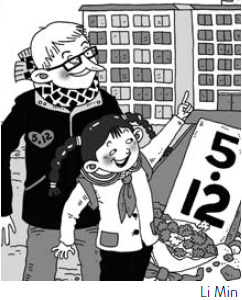New moms, new homes and a new zest for life
By Erik Nilsson ( China Daily ) Updated: 2010-02-10 13:43:00
We couldn't figure out where all of the buildings had gone.

All we'd seen from the car window for days were the crumpled structures of the Sichuan quake zone. The heaps of snarled rebar and concrete nuggets had stretched for hours, for days.
But these were nowhere to be seen in rural Qingping township, just across the Longmen mountain range from the disaster's epicenter, Wenchuan county.
The only clue to the edifices' whereabouts was a sign for the Ginko Holiday Resort. The inscribed concrete slab was leaning against a power pole that had bent into thirds.
Across the road, where the recreational spot - or at least its ruins - should have been, there was nothing but gravel.
That's when we realized where all of the buildings were - beneath our feet. Down the road, houses were flooded with rocks from the landslides that happened when the quake peeled off the mountains' stony skins, coating the surrounding settlements with boulders.
The top floors of several buildings poked out of the pours of earth that had inundated Qingping with flashfloods of rock. There was no way of knowing how many stories were buried underneath.
We stopped alongside the road at a place where someone had staked candles and incense in the ground in front of one of the mounds.
At that moment, the gravity of what we were witnessing came crashing down on us like the landslides that had buried so many.

The desolate panorama was absolutely silent and still. So were we.
Then, my Sichuanese friend pointed to a rippling puddle next to the stony drift, where hundreds of green tadpoles wriggled.
"Look," he said. "Life."
We both smiled. Indeed, in this now barren place, life was bearing testimony to its tenacity.
The Qingping trip happened about a year after the 8.0-magnitude quake claimed more than 70,000 lives in Southwest China. Since then, life has not only continued to endure but also has in many ways started anew.
A recent visit revealed a place now defined less by rubble and death than by new buildings and new life.
Of course, there's no bringing back those who were lost on May 12, 2008. And there's no absolute healing for their surviving loved ones.
But many once-devastated parts of Sichuan now host new mothers, women who have conceived after losing their children to the disaster. There are new houses and facilities, most of which are much better than those typically found in the country's hinterlands.
Construction is finishing up on Hongbai primary school in Shifang city's outskirts. The building is huge and incredibly modern, far better than any school I've ever seen in the West.
Like those tadpoles must have done by now, the quake zone's inhabitants seem to have metamorphisized. Rather than returning to their lives before the quake, they are creating new existences, in many ways better despite lingering traumas, losses and hardships.
Kuang Lipeng, an art teacher at Hongbai, says the birth of her now 6-month-old girl has helped her cope with the loss of her daughter who died when the school collapsed.
Teahouse manager Zhao Yangbo says low-income residents in Deyang city are buying pricey brews, because the disaster helped them realize we only live once and should enjoy it.
The disaster destroyed houses and homes but never hope. Hope doesn't always translate into reality. But in Sichuan, it is doing so a little bit more every day.
|
|
|
|
|
|
|
|


























 Raymond Zhou:
Raymond Zhou: Pauline D Loh:
Pauline D Loh: Hot Pot
Hot Pot Eco China
Eco China China Dream
China Dream China Face
China Face






